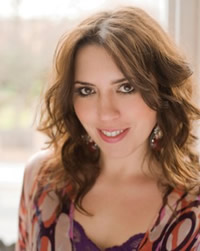The Covenant Presbyterian Church Concert Series presented the 19th-century guitar duo of Pasquale Rucco and Douglas James for the second of three series programs. These guys are getting around nearly as much as the Brazilian Guitar Quartet a few years ago; in addition to this concert, the Duo has appeared at Brevard College, Furman University, Appalachian State University, and the Oberlin Conservatory. It’s an interesting draw, too – the program material is popular even if the production techniques tend to be esoteric, and the ensemble effect is that of one instrument instead of two.
The Golden Age of guitar music is a brief thirty-year period at the beginning of the 19th century. The instrument had evolved to its current configuration (6 strings) and several virtuosi, wide amateur participation, and plentiful editions of popular themes fueled public imagination. This period also paired legendary composers from both guitar and opera.
Witness the first offering: Rossini’s Sinfonia nell’Opera Semiramide in a setting for two guitars by fellow Italian Ferdinando Carulli (1770-1841). Gioacchino Rossini needs no introduction, but you may not be familiar with Carulli. For sheer output, he was a Classical era Estebán (omnipresent shopping network hustler and late of GEICO commercials). Observing that the city of Vienna wasn’t big enough for him and Mauro Giuliani (more about him later), he moved to Paris where, between 1808 and 1823, his fame was earned with teaching, writing, and composing. In his lifetime, over 300 opus numbers were assigned to his compositions, and such prodigious output produced a few gems, including this opera Sinfonia.
Here we have all the hallmarks of Rossini’s orchestral writing technique very effectively condensed for two guitars. The full range of both instruments is employed, and as such they effectively convey both linear passagework and arpeggio. One characteristic of this era’s style is the manipulation of time to convey expression. In this respect Rucco and James seamlessly blend two parts as one complete sound at cadences, while slowing down, and when starting or stopping. If you don’t know what to look for, this amazing unity of sound would seem as if magic – or telepathy!
Next came the not-well-known-yet-talented François de Fossa (1775-1849) who, in addition to specific musical proclivities, saw service in the French military. He created the Grand Duo, Op. 2, No. 2, after the quartet Hob.III:8 of Franz Joseph Haydn. In four movements, it features great writing and excellent arranging of the original work. Rucco and James offered complete independence of fingers and hands and comprehensive navigation of the instrument, while mapping distinct timbre and dynamic contrasts. At this level what tune is in play really doesn’t matter. The real joy here is experiencing the ensemble.
After intermission, we heard from one of the more enigmatic composers, Antoine Baron de Barcó, whose birth and death dates were shown as 17??-18??. This rough period is established by compositional style more than anything else because we just don’t know anything more about him. This much we can say: his “Rondeau pour deux guitarres” starts off as a nice Viennese waltz in absolute style, and this was a nicely polished performance to accent the good writing. I would have preferred more harmonic development – wait, have I said that before?
This program ended with Rossini’s Sinfonia nell’Opera Il Barbiere di Siviglia arranged for two guitars by Mauro Giuliani (1781-1829), the other leg of the classic era guitar tripod along with Fernando Sor and Carulli.Wildly popular for salon performances, Giuliani pretty much had his way with the city of Vienna. On everyone’s A-list, he played cello in the premiere of Beethoven’s Seventh Symphony and had a guitar magazine named in his honor. Lines would form outside music stores on the day his editions of guitar music were first offered.
Again, Rossini’s music is revealing for all the famous themes we seem to know instantly. It’s all very busy, very demanding, and full of memorable moments for the ear – both real time and from the Merrie Melodies cartoons on Saturday mornings, lo those many years ago. More and more we must come to accept that, for many Americans, our knowledge of classic era opera really comes from those Saturday morning television programs – and somehow we no longer have that luxury! The Duo is adept at delivering these large-scale works with apparent ease – though it can’t be easy – and creating contrasts, multiple voicing, shimmering scales, and the grand landscape of symphonic music in a most convincing way.
The instruments used for this performance are the real thing – authentic 19th-century guitars rescued from closets or life on the antique circuit and now making concert tours. Rucco, of Italy, is playing a French guitar from c.1805/10, the maker is unknown. The American James plays an 1830 Jacques Derazey. Both instruments are strung with gut strings. This makes for a much different sound than a conventional classical guitar. For such diminutive voices, these instruments have remarkable clarity and articulation of parts. Familiar figures and harmony make that which you haven’t heard before – or that which at first sounds strange – even more welcome.
The encore was another familiar work from opera, the “Cavatina de Figaro” from Rossini’s Barber of Seville. This setting is taken from Diabelli’s Orpheus, where the duo arrangement with Terz guitar is one of twelve “light music” pieces. Terz, from the German word for three or third, is a smaller guitar tuned a minor third higher than standard. James played this instrument, giving a fresh new voice to the Duo’s sound and welcome new timbre to that familiar tune.
I have said before, there is an apparent dichotomy between the presentation of these seemingly light and soft instruments when matched with large-scale orchestral writing. Odd that it seems to work perfectly – on purpose – and as though you couldn’t imagine it any other way!
On second thought, maybe these guys are just good.











